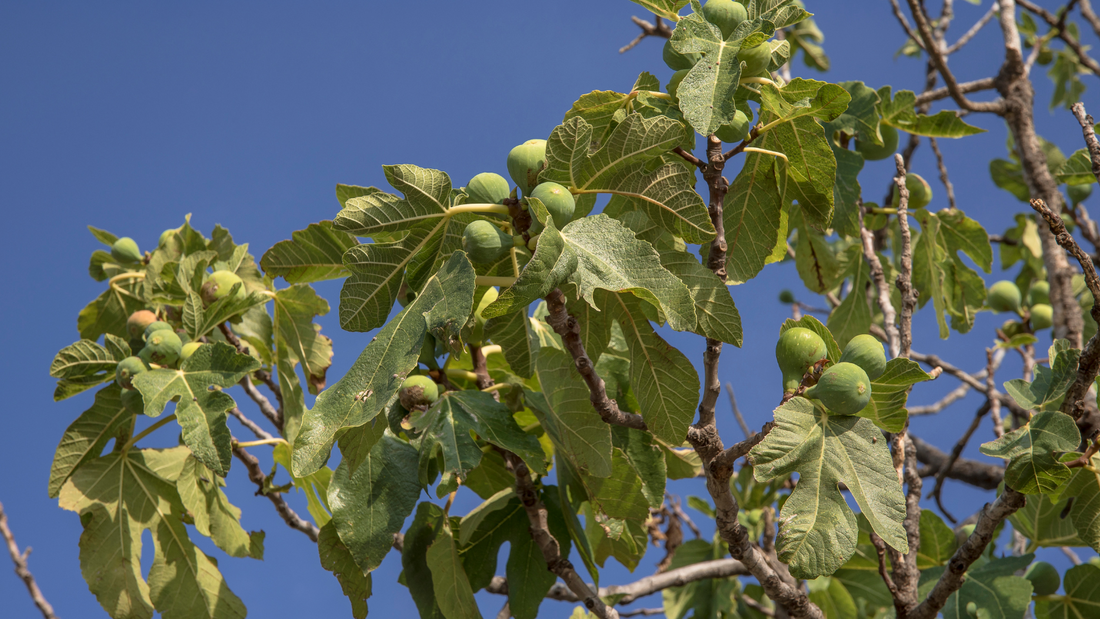Fig trees are unique in that they don't typically grow like a standard fruit tree. They don't always have a single main trunk (although they can), and tend to want to grow like a big bush with lots of "suckers" or side branches emerging from the base of the tree.
Each fig variety we have seems to like to grow a little differently. Violette de Bourdeaux trees tend to be smaller and more compact, whereas Mary Lane fig trees tend to grow more upright and get very tall if not pruned. You can also plant two trees of the same variety side-by-side and they each might have a slightly different growth pattern.
As a result, we get a lot of questions about pruning fig trees, how to prune trees, and whether pruning is necessary at all. Let me start by saying that pruning isn't necessary. But there can be some be some benefits to pruning fig trees, which we'll discuss below.
I've seen plenty of old fig trees that have just been allowed to grow and sprawl, and they're still productive decades later. There is a lot of technical info out there regarding fig tree pruning, but here we're going to keep it simple and explain why you might want to do so. If you are going to prune your fig trees based on one of the reasons below, you should do it in the fall or winter months once the trees have lost their leaves and gone dormant.
Why Should You Prune A Fig Tree?
#1 Limited Space
Many growers in the northern states will plant fig trees in large pots or other containers so they can better protect them during the winter months. In these situations, pruning is going to be advantageous because it keeps the tree size manageable. If you're having to move trees indoors during the winter, you don't want a massive, unwieldy tree that's tough to move.
Pruning trees is also helpful if you need to cover them for the winter. A large, sprawling fig tree is hard to protect when temperatures get in the low teens. But a more compact tree will be easier to cover and protect so that the growth from the previous year isn't burnt the ground by freezing temperatures.
#2 Removing Dead Limbs
Here in south Georgia, it rarely gets cold enough to damage our fig trees. But during the infamous Arctic Blast of late 2022, we did have some branches and limbs on our fig trees that were permanently damaged. It doesn't happen often, but it can when we get those record winter temperatures once every couple decades.
In regions north of us, all of the aboveground growth of the fig tree may be killed during the winter if the tree is not protected. When this happens, you'll want to remove those dead limbs before the tree starts growing again in the spring. It's pretty easy to tell when a limb or branch has been killed. It will usually be brittle and the inside will be hollow.

#3 Shaping the Tree
As mentioned above, the natural tendency of most fig trees is to grow like a big bush. So shaping a fig tree can be a bit more difficult than shaping something like an apple tree. It can be done, but it takes a little more persistence because the fig tree wants to keep producing those sucker branches.
If you want your fig trees to have a more traditional fruit tree growth habit, you'll want to remove those sucker branches. I'd recommend removing them in the fall once the trees go dormant, but you could do it as those branches develop throughout the growing season. We do have one Salem Dark tree that has a single trunk, but most of our fig trees have several main trunks at the bottom.
#4 Encouraging More Fig Production
Some varieties of figs will tend to have more vertical growth and not as many side branches. This usually results in lower production as the majority of the new growth comes on the top of the tree. But if you can force that tree to produce more lateral branches through pruning, you'll get more new growth and usually get more figs each year.
If you cut the tip of a fig limb, you'll usually see 3-4 side branches develop below that cut the following year. This will result in more new growth, which will also result in more main crop figs. We see significantly more production from the trees that are pruned heavily when taking propagation cuttings each year.
Some fig growers recommend maintaining good air flow between the branches of the tree, so there is healthy medium here. You don't want to "top" every single branch of the tree because that might cause some congestion in the center of the tree. But topping a few of the branches each fall should force more new growth and more figs the following year.

